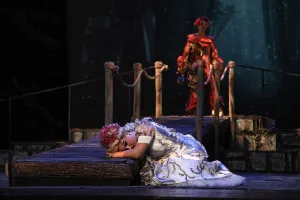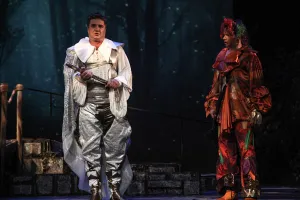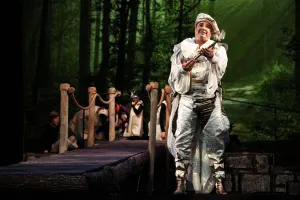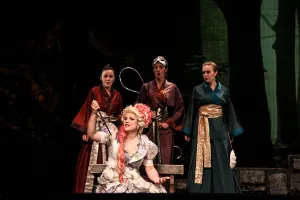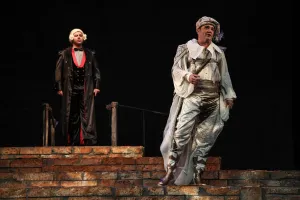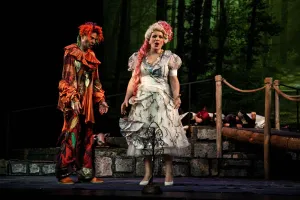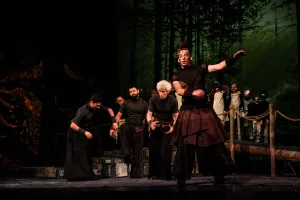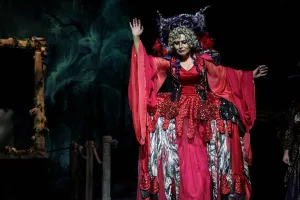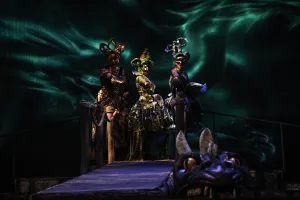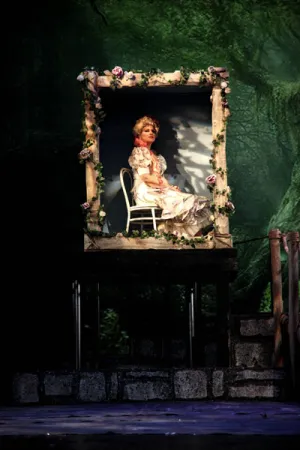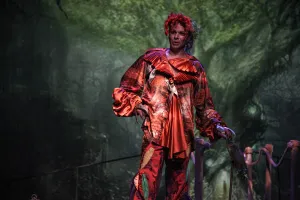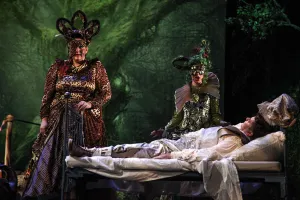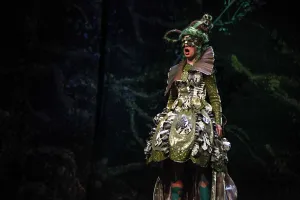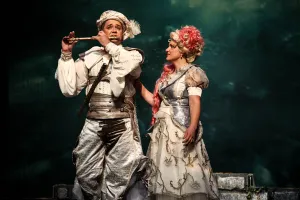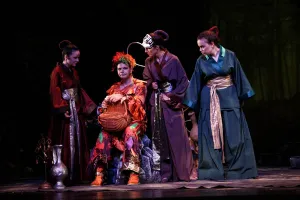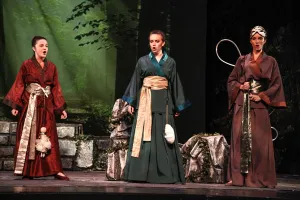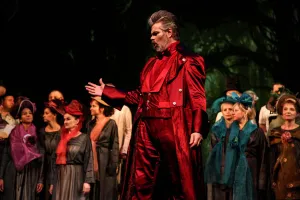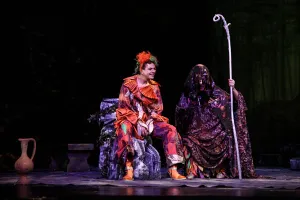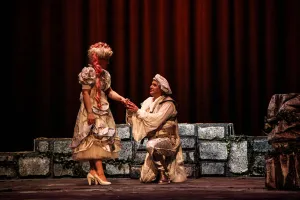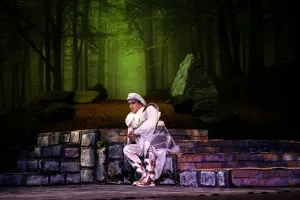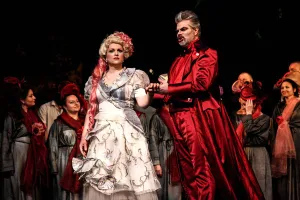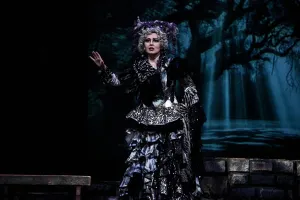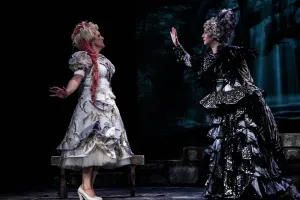The magic flute
opera by W. A. Mozart

FIRST PERFORMANCE OF THE MAGIC FLUTE
In September 1791, Mozart returned to Vienna from Prague, where his opera Titus premiered. He immediately dedicated himself to finishing The Magic Flute, which he started in March; on 28th September, he finished the score and the premiere took place only two days later, on 30th September. The audience did not particularly appreciate the performance in the beginning. Mozart had seen several performances of his opera and he was happy with the way it has been received. Nonetheless, he died on 5th December that year, so he did not have an opportunity to enjoy the success of the opera as Schikaneder did. Sources for The Magic Flute were numerous, but the most important one was Wieland’s fairytale Lulu or the Magic Flute from the collection Dcschinnistan. The book, published in 1786, also contains a story Wise Boys in which the wise young men advise another young man who wants to save his beloved to “be persistent, patient and silent”. The magic flute and bells also appear in the book. Schikaneder had already staged the opera The Philosopher’s Stone or the Magic Island, to the music of several authors, which also contained elements from Dcschinnistan. Novel Life of Sethos by Jean Terrasson was very popular at the time and its German version translated by Matthias Claudius was read a lot. The Wise King Sethos is the source of Sarastro’s character and the act of dedication was exquisitely portrayed. Motifs of snake, Queen of the Night and her ladies, the flute created by Oziris and the three boys can also be found in the book. Dedication is completed through ordeals while conquering water and fire. Some of the scenes in opera have been almost completely taken from the novel. Let us not forget that both Mozart and Schikaneder were members of a Masonic Lodge and that some of the Masonic traditions were portrayed in the opera, therefore the opera has always been appealing to freemasons around the world…
On the playbill for the first performance of The Magic Flute on 30th September 1791, it was written that “out of courtesy to kind and respectable audience and out of his friendship with the librettist, Mr. Mozart will conduct the orchestra himself”. The orchestra had 35 members, out of which 5 first and 4 second violins, 3 violoncellos and 3 basses. There were 12 different sets and 10 changes on the open stage as well… Mozart also played a solo on the glockenspiel. Although the premiere received only a lukewarm success, already at the second performance the audience properly appreciated the Mozart and Schikaneder’s masterpiece, so The Magic Flute was performed almost every evening. Mozart saw several performances; he also took his guests to the opera… In a letter to Constanze dated 7th October 1791, Mozart wrote, “I have this moment returned from the opera, which was as full as ever; duet between the man and the women as well as the bells from the first act were performed again as usual, and the trio of boys from the second act as well… But what always gives me the greatest pleasure is the silent approval! You can see how this opera becomes more and more esteemed.” By the end of October The Magic Flute was performed 24 times, until November 1792 it had 100 and by 22nd October 1795 – 200 performances. The opera soon conquered Prague, Frankfurt, Weimar, Berlin, Hamburg. In 1801 in Paris, the opera has been adapted in a way we find implausible today; in 1811, the opera was staged in London; in 1816, in Milan; in 1818, in Saint Petersburg; in 1832, in Philadelphia.
Konstantin Vinaver, The Magic Flute, 1994
 WOLFGANG AMADEUS MOZART (1756–1791)
WOLFGANG AMADEUS MOZART (1756–1791)
Mozart, a composer of symphonies, concert, chamber and spiritual music, has always shown a great interest in opera as well. He wrote to his father, “I have always wanted to compose operas, it’s my obsession.” Out of twenty-three operas written by Mozart, the first ones were, quite naturally, composed in the style of Napolitan operatic school, which dominated in Europe. The pieces do not present any specific traits, except several dramatic emphases the composer would also use in later periods. The first period consists of eleven operas, some of which are Bastien and Bastienne, Lucius Sulla, The Shepherd King. In the second period, which lasted for ten years (1775–1785), the intonation and drama intensify, the quality becomes less conventional; Mozart wishes to create synthesis between opera seria and opera buffa, Idomeneo is his first great dramatic piece, The Abduction from the Seraglio is his first opera in German. As for the third period of his opera composing, we can declare that his development can be clearly identified, starting from the comic opera – The Marriage of Figaro, Cosi fan tutte, through dramma giocoso (Don Giovanni) to The Magic Flute, the first great opera in German language. By accepting the basic principle of Italian operatic aesthetics, which finds music more important than drama (“…in opera, the poetry must be altogether the obedient daughter of music.”), Mozart achieved a synthesis of the Italian musical style with German emotion and created four masterpieces, which are integral parts of standard opera repertoire today. In the final period of his opera composing, Mozart turns towards German Singspeil, a play with music (…) “Every nation has its own opera,” wrote Mozart, “Why shouldn’t we, the Germans, have our own? Isn’t it equally difficult to sing in German, as in Italian, French or Russian? I prefer German opera, even though it means more trouble for me.”
Branko Dragutinović, Musical, Dramatic and Ethical Values in The Magic Flute by Mozart,1971
In 1778, Emperor Joseph II established a special theatre for German Singspiel in order to promote operas in German language. Besides the newly commissioned singspiels, Italian buffo operas and French comic operas translated into German were also performed, though without significant success. Therefore, as early as in 1783 it was ordered from the ‘top’ to establish an Italian opera in the old Burgtheater. The “in-house” librettist was Lorenzo da Ponte, while Antonio Salieri was the manager. Mozart had a lot of success with his singspiel The Abduction from the Seraglio; he cooperated with Da Ponte on commissioned operas The Marriage of Figaro and Cosi fan tutte, while Don Giovanni was written after a request from Prague. Mozart was a renowned, established and liked author, but he has not been a master of the operatic scene in Vienna at the time. According to records, the most popular operas were written by Paisiello and Salieri, followed by operas by Martin Soler, Cimarosa, Guglielmi, Sarti, while Mozart was only on the seventh place in period 1783–1792. The most popular opera was L'arbore di Diana by Soler, followed by The Barber of Seville by Paisiello with 62 performances, The King Teodoro of the same author with 59 performances, also the operas by Sarti and Soler named in the finale of Don Giovanni, then Aksur by Salieri with 51 performances and, finally, Mozart’s The Marriage of Figaro with 38 performances! The most preferred operas at the time have been forgotten today, almost without an exception…
Konstantin Vinaver, The Magic Flute, 1994
 IVANA DRAGUTINOVIĆ MARIČIĆ
IVANA DRAGUTINOVIĆ MARIČIĆ
Ivana graduated from the Piano Department at the High School of Music, and from the Mathematical Grammar School. She got her university degree from the Department of Opera Stage Directing at BK Academy, in the class of Professor Mladen Sabljić and Professor Gordan Dragović. Since 1998, she has been working as an assistant director in the National Theatre and the Chamber Opera Madlenianum, and since December 2003, she has been engaged as a stage director in the Opera House of the National Theatre. Ivana directed the following operas: The Troubadour by G Verdi, Suor Angelica by G. Puccini, The Wife Hassan-Aga by R. Kambasković, Traviatta by G. Verdi (partly revived stage directing of B. Popović) – performed on the National Theatre’s Main Stage; The Marriage of Figaro – Variation by W. A. Mozart and The Secret Marriage by Domenico Cimarosa (directed in cooperation with Radoslav Zlatan Dorić) – performed on the “Raša Plaović” Stage. She has directed the play One Century of the Politika staged for 100 years’ anniversary of the Newspaper Agency Politika (2004). She has also revived the original stage directing by Mladen Sabljic of Don Carlos by G. Verdi and adapted Salome by R. Strauss (originally directed by Bruno Klimek, Germany); with this play, the Opera Ensemble of the National Theatre had successful tours in Italian towns of Ravenna and Rovigo. In 2009, together with colleagues from the National Theatre, she toured Portugal with Mozart’s Don Giovanni, specially prepared and directed for the Silves Summer Festival. The following season, she revived Borislav Popović's stage directing of The Barber of Seville by Rossini. As an only permanently engaged stage director she has maintained almost complete opera repertoire for more than 12 years, and as a director and assistant director in the National Theatre’s Opera, she cooperated with many local and international artists on the following operas: Witches of Salem, Attila, Madame Butterfly, Cinderella, Hansel and Gretel, Magic Flute, Werther, Elixir of Love, The Bat, Pagliacci, Cavalleria rusticana, Gianni Schicchi, Violet Fire, Carmen, Italian Girl in Algiers, Nabucco, La Boheme, Rigoletto, Tosca, Aida and many others; and in the Madlenianum Opera: The Rape of Lucretia, Die Kluge, Two Widows, Cosi fan tutte. Ivana is a member of artistic management of the National Theatre’s “Borislav Popović“ Opera Studio and she works as a professor of Opera Studies at the Academy of Fine Arts in Belgrade. Ivana is a member of MENSA, and in March 2011, she became a mother to a girl, who completes her both as a woman and as an artist.
 STEFAN ZEKIĆ, Conductor
STEFAN ZEKIĆ, Conductor
Stefan Zekić was born in Belgrade in 1983. He graduated from the Department of Conducting; he is currently an advanced student at the Department of Solo Singing at the Faculty of Music Arts in Belgrade. He has attended advanced trainings and workshops with renowned conductors: Uroš Lajovic (Austria), Andrew Parrott (Great Britain), Max Frey (Germany). Stefan is attending doctoral studies at the Department of Conducting at the Faculty of Music Arts. Zekić has been conducting orchestras since he was seventeen; in 2006, he became a chief conductor in the oldest Jewish choir in the world – the ''Braća Baruh'' Choir, established in 1879. He is a founder and artistic manager of an early music ensemble ''Canticum novum''. Since 2010, Zekić has been engaged by the National Theatre in Belgrade as a conductor and musical assistant. He conducted the following operas: Le nozze di Figaro (W. A. Mozart) and Lucia di Lammermoor (G. Donizetti); and participated in preparations and maintenance of the following opera repertory: G. Donizetti: Italiana in Algeri, Don Pasquale; G. Rossini: Il Barbiere di Siviglia; G.Verdi: La Traviata, Rigoletto, Il trovatore, Attila, Nabucco; G. Puccini: Suor Angelika, Il Tabarro, La Boheme, Tosca; P. Mascagni: Cavalleria rusticana; G. Bizet: Carmen; R. Wagner: Der fliegende Holländer. As a guest conductor he conducted in numerous concert with various ensembles, such as: Madrigal Choir and Symphony Orchestra FMA; vocal ensembles: Oktoih, Marienhain (Germany), Musica (Slovenia), Royal Strings of St. Georges, Jewish Chamber Orchestra, Symphony Orchestra Stanislav Binički, etc. He performed in several hundred concerts in the country and abroad. Zekić won numerous recognitions and awards in the most prestigious international festivals of choral music, as well as a special medal awarded by Israel for his accomplishments regarding Jewish music.
A Note by the Stage Director
MOZART’S AND OUR TEMPLE OF THE DEDICATED
This ingenious Mozart’s opera entertains and amuses a child within me and, on the other hand, intrigues the intellect, knowledge and experiences of a grown up. It is my good fortune that I cooperate with young artists and that we all find ourselves profoundly dedicated and resolved to produce a true masterpiece, because Mozart deserves nothing less. I have the impression that the rehearsals regenerate me somehow, because I witness a process of creation of something meaningful that carries a strong message, which we send out to audience, but also to ourselves and to our children. Today, at the time of aggressive enforcement of “subculture” and rudeness going wild everywhere around us and influencing upbringing of our children, and ourselves for that matter, whether we want it or not; regardless our best efforts to defend ourselves and avoid looking in that direction, we cannot go through life with closed eyes and plugged ears. We have to find a serene place of our own, our own oasis and sanctuary of wisdom, knowledge, beauty, truth and happiness, where we can take our souls to relax and let our hearts experience elation, while our intellects can wonder and grow by exchanging thoughts, impressions and feelings with those similar to us, we may even call them the “chosen” ones. Of course, I am not referring to a privileged group of people who have power or anything similar; I am referring to all those who are different because they have God given talents. Some people would say that talents are given by the Gods – everybody is free to believe what they want. Our staging is new and different because it is placed here, amongst us, in this (and every other) time. We grow together with the main character, Prince Tamino, we experience troubles, surrounded by the forces of Evil, but we turn toward the forces of Good and we believe in them and in our choice on the road to elation and dedication, on the road to growing, emotionally and intellectually. During the first readings (of score and libretto), an interesting association appeared in my mind: Sarastro = Maestro... Maestro / Sarastro... Great Master of the Lodge / theatre loges... Temple of Wisdom / Temple of Culture... And there was the answer! I have understood our National Theatre to be the Temple of Wisdom, Knowledge and Dedication, since the Theatre has always been, still is and will be, the Temple of Culture with its three arts – Opera, Drama and Ballet. If you find yourselves at a drama rehearsal and see how actors, dramaturges and other members of the production team cooperate with a stage director and other authors and work on bringing a text to life by turning the written word into theatre, you will become aware that you are a witness to the conversation of the Wise. If you happen to see any of various rehearsals that happen in the Opera every day – the piano, ensemble, stage directing, orchestra, choir, stage and orchestra, special, sound and technical rehearsals... you will grasp that the functioning of such a complicated organism demands a lot of Knowledge from everybody involved. If you take a peek into the ballet rehearsing hall early in the morning and see someone who does not even notice your presence in a mirror because they are concentrating on reaching the perfection of movement, you will understand what Dedication is. I am lucky to be able to visit our true Temple every day and to serve The Art and its higher purpose with dedication, knowledge and wisdom as much as I am capable of, by giving everything I have and expecting others to do the same, even at the hardest of times and circumstances, believing in success even when it does not happen, knowing that somebody’s heart has been touched that evening, that a child smiled, that people were served a portion of our magic at the price of a ticket and that they got distracted from their problems by being carried away and taken into somebody else’s lives, who perhaps changed a little bit forever, maybe became a better person for a little bit. This is why I did not have to invent an abstract Temple...
Taken from the interview On the Road toward Growing Together
The Theatre Newspaper no. 89, May 2015
Interview conducted by Mikojan Bezbradica
Premiere performance
Premiere 17th June 2015
Main stage
Opera in Two Acts
Libretto by Emanuel Schikaneder translated by Stanislav Binički
Conductor Stefan Zekić
Stage Director Ivana Dragutinović Maričić
Set Designers Miraš Vuksanović, Jasna Saramandić (set design and video materials were made after Ivana Dragutinović Maričić’s idea)
Costume Designer Katarina Grčić Nikolić
Assistant Costume Designer Ružica Ristić
Choreographer Aleksandar Ilić
Video Production Balša Đogo
Video Effects Studio Mosquito
Cast:
Sarastro Nenad Jakovljević / Dragoljub Bajić / Mihailo Šljivić / Strahinja Đokić *
Tamino Dejan Maksimović / Marko Živković / Stevan Karanac / Nenad Čiča
The Speaker Mihailo Šljivić / Đorđe Tomić / Strahinja Đokić*
The Queen of the Night Snežana Savičić Sekulić / Aleksandra Jovanović / Ivanka Raković Krstonošić / Nevena Matić
Pamina, the Queen’s daughter Sofija Pižurica / Aleksandra Stamenković Garcia / Jelena Janjić*
The First Lady Milica Stojčev* / Slađana Stošić*
The Second Lady Jelena Škorić* / Maja Pavković*
The Third Lady Jelena Petrović* / Nataša Rašić*
The First Child Ana Šipka* / Milica Stojčev* / Slađana Stošić*
The Second Child Jelisaveta Cvetković* / Jelena Škorić* / Maja Pavković*
The Third Child Nataša Rašić* / Jelena Petrović*
Papageno Vladimir Andrić / Vuk Matić / Pavle Žarkov / Marko Kalajanović / Gavrilo Rabrenović
Papagena Nevena Matić / Slađana Stošić* / Ana Šipka*
Monostatos Slobodan Živković* / Ivan Debeljak / Mihailo Otašević*
The First Armoured Man Mihailo Otašević* / Slobodan Živković*
The Second Armoured Man Strahinja Đokić* / Mihailo Šljivić / Gavrilo Rabrenović
Ballet Duo Jana Milenković and Branko Sarić
The Dedicated, people
ORCHESTRA AND CHOIR OF THE NATIONAL THEATRE IN BELGRADE, Children’s Choir “Horislavci” under leadership of Draško Janković and Aleksandra Stanković
* Members of the “Borislav Popović” Opera Studio of the National Theatre in Belgrade Vocal pedagogue of the Opera Studio of NT Suzana Šuvaković Savić
Associate for stage speech and pedagogue of the Opera Studio of NT Andreja Maričić
Concertmaster Edit Makedonska / Vesna Jansens
In Charge of Stage Music Dijana Diskić
Solo Bells Nada Matijević
Chorus Master Đorđe Stanković
Music Associates Srđan Jaraković, Nada Matijević, Dijana Diskić, Nevena Živković, Gleb Gorbunov
Organizers Maša Milanović Minić, Snježana Vujasinović Đorđević, Nemanja Stanojević
Stage Managers Branislava Pljaskić / Ana Miilićević
Prompters Silvija Pec / Biljana Manojlović
Make-Up Designer Dragoljub Jeremić
Lighting Master Srđan Mićević
Stage Master Zoran Mirić
Sound Master Tihomir Savić
Video Operator Aleksandar Savić
Sets were made in the National Theatre’s workshops under supervision of Goran Milošević
Costumes and shoes were made in the National Theatre’s workshops
Male costumes’ designer Drena Drinić
Head of male costumes tailor shop Jela Bošković
Female costumes’ designer Radmila Marković
Head of female costumes tailor shop Snežana Ignjatović
Head of shoemaker’s shop Žarko Lukić
Costume Accesories Radica Komazec
Design of hats, masks and accesories Ružica Ristić with associates Marina Dželata and Sara Bradić

